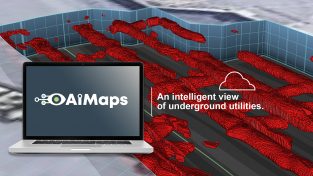Corbins Electric continues to grow their internal offerings with Xalt, finding infinite solutions to business problems and improvements to processes.
BK: Welcome to HxGN Radio. My name is Brian, and I have the honor of welcoming CEO Justin Martin and CFO Jessica Grant from Corbins Electric to discuss their company’s recent honor of being selected a 2019 Hexagon Honouree. Corbins Electric is an electrical-contractor organization specializing in commercial and heavy industrial projects. Since 1975, the company has continued to lead the industry with state-of-the-art technologies. Corbins Electric practices Lean construction and looks for increases in efficiency and waste elimination by sharing new and innovative ways to complete tasks and standardize processes. They are championing innovation by bringing sustainability to the construction industry, with help from solutions powered by Hexagon’s Xalt technologies. Justin, Jessica, thank you both for joining us.
JG: Thank you for having us.
JM: Thanks, Brian.
BK: We are extremely honored to have you as one of our customers and very excited to have you on the show to talk about innovation in your industry. So, first of all, tell us a little bit about Corbins Electric, what you do there.
JM: Well, Corbins is a full-service electrical contractor, operating in Arizona and New Mexico, and we provide electrical services and BIM and prefab services for the electrical industry in the Southwest.
BK: Okay. Tell us a little bit about the biggest challenges that are facing your industry today.
JM: Certainly the biggest challenge facing our industry is the lack of skilled labor, qualified manpower. One of the ways that we’ve been combating that is through innovation and being able to get more done with less people and people that aren’t necessarily trained to the same level or for the same number of years as the workforce in the past.
BK: So, technology, always good and bad. How is it offering a solution, or how is it making things harder? I mean, you can even answer both those questions on that.
JG: Can’t think of a specific example that’s making it harder, but it’s definitely offered solutions for us, especially in the field, with shoring up some people’s inefficiencies at their lack of training. It kind of bridges those gaps in some ways and then also makes some mediocre tasks, like payroll processing and data entry, almost nonexistent.
BK: So, what are you doing to help your customers adopt the new technology?
JG: I think some of our suppliers have been looking at similar products that we use.
JM: As an electrical contractor, we are on the front end and the kind of the close out of every single construction project, and we’ve been providing leadership with the other trades and with the general contractors and the implementation of the technology. It certainly impacts the MEP contractors the most, and it’s been a process in training both the customer, the general contractors, and our trade partners on how the technology can be leveraged to speed up the construction process and provide a better product in the end.
BK: Now, are you having a hard time keeping up with some of the new technology in your industry at all?
JM: Sometimes I think we’re on the bleeding edge of technology implementation at Corbin, but—
JG: And the construction industry in general is lagging, so it doesn’t feel like we are having a hard time. No.
JM: No, it doesn’t. I mean, certainly one of our core values is to adopt, implement, create technology solutions. And if there’s something that’s new out there, we’re typically testing it before it goes to market, and keeps our people motivated and excited, even if our investment’s out ahead of most people’s.
BK: So, by pretty much being early adopters, you’re on that cutting edge. You’re getting in before everyone else is, which is great, but you’re finding that that’s obviously helping you out quite a bit, then.
JM: Yeah. I think that there’s been a lot of contractors, especially lately. It is an intimidating thing. Most people didn’t get into construction with this in mind. A lot of them have reached out, and things are becoming a little more open and sharing and transparent across the board. And we’ve had a lot of contractors reaching out, looking for help in their own businesses and implementing things, and we’ve certainly been willing to help them because we see the need for these solutions to be adopted across the board in our industry. It can’t just be one or two contractors, or one or two geographical areas that are utilizing technology to increase productivity. We need to be doing that as an industry and make those things standard in order to really advance and continue to bring and keep businesses to our areas where we live and work.
BK: So, what would you see problem-wise if you weren’t using this technology?
JG: Specifically, Xalt? A lot of rework, especially for our support functions in our business like purchasing and payroll. We’ve seen a lot of that disappear just because it’s not a paper process or people. It’s all data validated, all the information we’re receiving. I think that’s really helped us keep overhead expenses in check through some massive growth we’ve had.
JM: Yeah. And then, more kind of in general, bigger picture, I truly believe that small- to mid-sized contractors who aren’t engaging these technologies and implementing them are going to be rolled up eventually. I think there’ll be less businesses doing a larger percentage of the business because we are one of the largest industries, I think the second largest behind food, and one of the most disconnected in the sense of the number of individual service providers and construction. BK: Well, tell us a little bit about how your team identifies ways to be innovative.
JM: Some of our innovation comes through the smallest ways and most unsuspecting ways. Sometimes it takes the person who has the least amount of experience to ask—
JG: Notice something.
JM: Yeah, notice something. —to ask some of the questions, why do we do it this way, and really challenged the status quo and the way things have been comfortable. Electrical construction’s been the same for a long time.
JG: I think what we’ve done is with our cultures created a very open environment that’s receptive to new ideas, so people aren’t afraid, they’re very empowered to say, “Hey, I think we should do this different,” just in the way that we communicate around here.
JM: And that’s absolutely key.
JG: Otherwise, they wouldn’t feel like they’d be able to talk about it. But they’re definitely bringing stuff up.
JM: Yeah, it is a lot of soft-skills training for our management to make sure, even if we vetted out an idea that someone else has to them for the first time, how to take that feedback and move past it without shutting them down so that the next great idea that they have that we haven’t vetted out we don’t fail to hear. So it certainly, as Jessica mentioned, it starts with culture, absolutely.
BK: That’s wonderful. I’m glad you actually are able to take that from your employees and let them speak up, let them suggest those things. You know, that’s obviously not something that’s always common, so I’m glad you’re doing that. Obviously, it’s helping you out, helping your company, and your culture’s thriving and everyone else is thriving. I mean, it really is just kind of this awesome circle, if you know what I mean.
JM: Yeah, it’s their company, and we’re here to be good stewards of it and facilitate that innovation, and we’re accountable to them to continue to create that space so that they can continue to do all those great things that they do.
BK: Do you have any specific ways that you actually encourage your people, your culture, basically? So, for example, like group research, team brainstorms, any specific ways and tips that you would even recommend to others?
JM: Yeah. We certainly have some dedicated resources that are constantly developing. But across the board, we create platforms through daily huddles at all of our office locations, and then we use some online employee-engagement applications that have—there’s targeted questions, but there are suggestion boxes. It was a virtual suggestion box that’s available at all times to 100% of our employee base. So that feedback comes straight to the leadership team, and we’re able to engage them through that platform. And sometimes we get great ideas that way.
JG: We also have taken our middle-management group. They’re creating smart goals for their kind of business units, and a lot of those have been around mapping processes in their departments and making them better. A lot of times it’s making them better with technology, and that’s driving a lot of change for this upcoming year right now, kind of pushing them to do that.
BK: All right. Well, last thing I want to ask is—and you’ve already sort of answered this—but a little bit more specifically, how has Hexagon technology supported your innovation efforts, specifically with Lean principles?
JM: So the way that we’ve utilized Hexagon technologies and specifically Xalt has really gone beyond taking processes, connecting them together, and making them digital and automated. And that, in and of itself, is phenomenal for efficiency. Really, what we’re able to do through the platform is we’re able to actually influence behaviors of the individuals that are engaging the platform. And that actually influences the culture overall, it kind of eliminates a lot of the tensions and constraints between human beings because it’s flexible and you can build what you need the way you need it as you need it, and then see how the engagement goes and react and adjust very quickly on the fly, and change that, see if you’re getting the result that you were looking for, and if not, go back and make some adjustments so that you can get that result. One of the kind of unexpected joys of trying to find some efficiencies through the platform has really been people finding more value, more worth in their role, and really seeing their impact in what we’re doing collectively. And it was kind of unexpected, and now it’s really become more of a driver for us.
BK: Justin, Jessica, thank you very much for time and for sharing all this information. And, again, congratulations.
JG: Thank you.
JM: Thank you.
BK: For more information on today’s discussion and on Corbins Electric, visit hexagonxalt.com and corbinselectric.com. And, of course, to learn even more and listen to additional episodes, head over to hxgnspotlight.com. And thank you so much for joining us here on HxGN Radio.
















